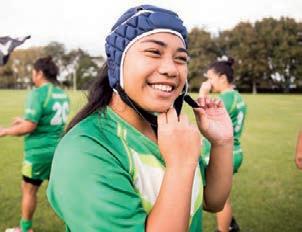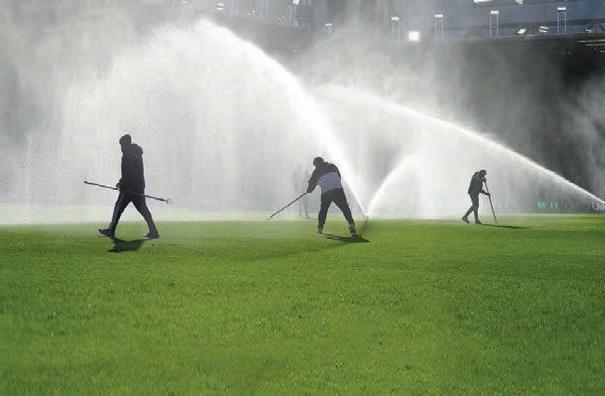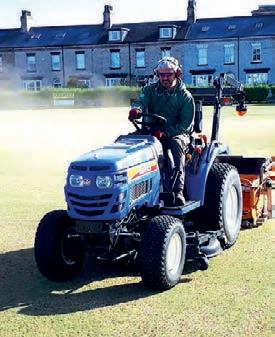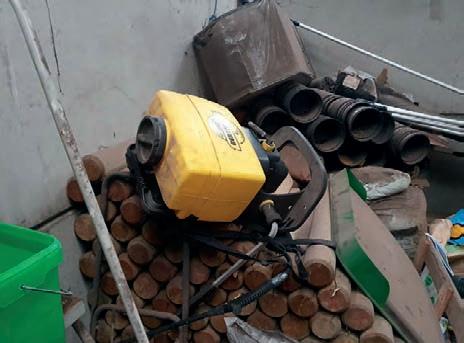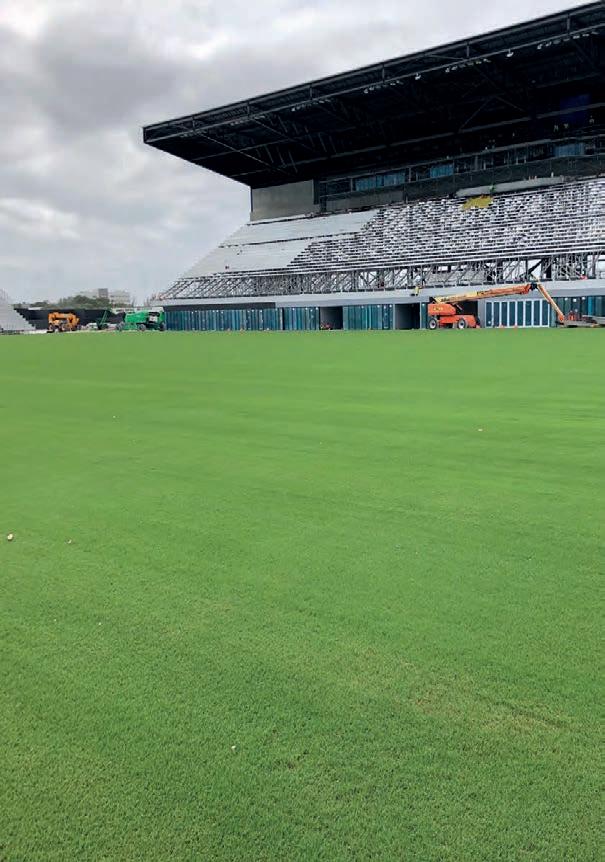
9 minute read
Best practice
B E S T P R A C T I C E
TEAMWORK COUNTS
Sussex CCC head groundsman Andy Mackay stresses how teamwork prevails in the continuing achievements of his team – especially when music concerts decimate the pitch
Maintaining a First Class cricket pitch, including net areas and an outfield, is no easy task. But that’s
not all Andy Mackay and his team have to manage.
At Sussex CCC there are also three satellite grounds covering 10 hectares, the surfaces for First Class cricket festivals at Arundel Castle and Eastbourne CC, and, perhaps their biggest challenge of all, restoring the main pitch after music concerts decimate the surface midway through a season. However, the skill of Andy and his 10-strong team has never been in question, especially over the past two seasons – which goes some way to explain why they have been c rowned the 2019 IOG Headland Amenity Professional Cricket Grounds Team of the Year.

“Everything we achieve – at the Brightonandhovejobs.com County Ground, the Allfield academy ground, the Brighton Aldridge Cricket Academy (BACA) and at Preston Nomads CC – really is a team effort,” says Andy. And that includes how the team deals with the aftermath of having crowds of up to 20,000 pound the County Ground pitch during music concerts.
“Having two concerts one after the other really batters the turf,” he says. “With a typical eight-day build-up, the trackway causes the most damage and invariably leaves a disease-prone surface that is akin to silage rather than grass. We had two all-seater concerts in 2018 with the builds either side of a six-day gap and in the middle of the cricket fixtures. Again, in 2019, we had two concerts, this time with a threeweek gap between builds and with games in between.
By Colin Hoskins Features editor
WHO IS ANDY MACK AY?
Andy joined Lytham CC multisports venue for a summer job while studying A-levels and attending university. He then moved to St Annes CC as a full-time groundsman. During this time, he completed his HND in turf science at Myerscough College, before taking on Blackpool CC. He joined Sussex CCC in 2006, becoming head groundsman in 2008, and re-entered formal education in 2014 to undertake a BSc in Turf Science, again at Myerscough College, which he completed in 2015.
With such a CV – including a BA in Ancient History and Archaeology – it is no surprise that Andy is an advocate for training and education; his deputy and two senior groundsmen are accredited to Level 3, while the senior groundsman at Preston Nomads CC is undergoing his Level 4. Everyone else in the team either has, or is, studying towards a Level 2, except an apprentice on a higher apprenticeship qualification.
Andy points out that apprenticeships have been a focus at Sussex CCC since 2009 and 18 apprentices have successfully completed the programme. “Our apprenticeship programme brings immense value to the team; it means that members are refreshing their knowledge as they are always being questioned by the apprentices. It means we never get stale; we are forever thinking about what we do and why we do it.”
Head groundsman Andy with West Indies batsman Chris Gayle Excellence in performance and presentation are what the grounds team strive for; all 18 wickets have been re-laid
“But the team negotiated these events very well, thanks to a combination of well-planned pre-stress conditioning of the turf, a proven post-concert recovery plan and... plenty of graft. Even where we lost grass cover on parts of the stage area, we managed to re-establish it and got the surface fit for play very quickly, without any fixtures being affected.”
QUICK TURNAROUND Indeed, in 2019, the team had to bring the surface back and ensure it was functional for a televised game scheduled just seven days after the second concert.
Andy says: “In an ideal world, we would have Koro’d the surface but, with such a short gap, there was no time for that. So, we reduced the height of cut and heavily overseeded – 100 gms/m2 – then applied water and fertiliser (during the season, our entire fertiliser programme is derived from liquids, to give us the most accurate application). Luckily, we had a very warm spell, so the seed germinated well and we had grass cover for the game. We couldn’t cut it, but it striped well with brushing and it looked OK. The outfield is normally kept at 9mm during the summer, but we left it alone while the concerts were on.”
Aside from such musical ‘hiccups’ in the groundscare regime (as well as around 30 days of other non-cricket events at the Hove site near Brighton), Andy and
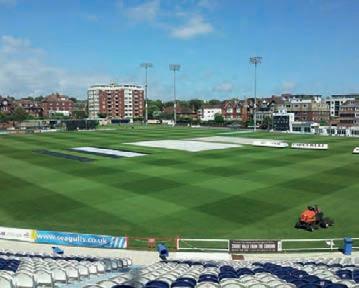
his team religiously present outstanding pitches at all the venues they maintain, especially the County Ground, where the 18 wickets are well used throughout a typical season. In 2019 this extended from 25 March through to 26 September, plus three additional days for corporate and children’s matches. The ground hosted:
51 days of pro-cricket, three days of women’s cricket (including the Kia Super League Finals day), 10 days of other cricket games and 25 days use of the outfield for community or corporate events, as well as 50 practice days. In addition, the off-field turf net area was used six or seven days a week The academy grounds (two sites) accommodated more than 100 match days, plus 30 training sessions – the off-field net area was in use five days a week
Deputy head groundsman Greg Denton
BACA hosted 50 match days – the ground was in use five afternoons a week Preston Nomads CC saw more than 120 adult matches over two grounds plus 40 colts games.
“Presentation of the playing surfaces is prioritised second only to the performance of the surfaces,” says Andy. “I’m proud to say the quality of the playing and practice surfaces has been consistently outstanding. We continue to have some of, if not the, best practice nets in the country, and the same can be said for our outfield, both in terms of presentation and performance.”
Groundscare expertise aside – and there’s no doubt that the grounds team has this in abundance – the consistent performance of the surface is also undoubtedly down to a square rebuilding plan that was instigated in 2009 by Andy. The process of rebuilding two to three pitches at a time was completed in 2016 (see above right) and it has transformed the “low, slow wickets” into ones that are quick and bouncy, and “widely acclaimed as being exciting to watch cricket being played on”.
THE LONG GAME Included in the site’s regeneration process over recent years – which has also seen the outfield remodelled (at a cost of just £50,000, compared with the ‘usual’ £600,000) from “a poorly-draining outfield characterised by heavy thatch” to one with automatic irrigation and reconstructed practice nets – has been the installation of hybrid pitches. There are three, so far, at the County Ground, plus three in the nets, and one at an academy ground.
“Hybrid surfaces are not a silver bullet,” says Andy, “but they do result in a surface that is more resilient and harder wearing than natural grass, plus we’ve seen an increase in surface hardness of about 20 per cent on the Hove pitch, installed in 2019, and also greater pace from the
WICKET WIZARDRY
The County Ground’s 18 wickets have all been re-laid to Andy’s specifications.
“In the ‘70s and ’80s, the wickets were renowned as being very quick, but they slowed down tremendously during the ‘90s,” he says. “However, the expectations continue to rise for everyone involved in the game and I didn’t want this ground to get left behind. I knew we had to do something.”
He says most of the wickets were as old as the site (more than 130 years) and while two pitches were re-laid in 2000, the rest of the square had ‘grown’ out of the successive layers of topdressings.
“The total depth of appropriate cricket loam on the square was about 80mm – very shallow and not enough to produce bouncy wickets. But the main problem was a severe horizontal fracture in the soil profile at 25mm, probably caused by the use of Marl as a topdressing in the past, as well as several other fractures through the profile.”
Two designs of wicket were applied; one sitting on a 120mm base of coarse grit (to create a solid base) enabling the wickets to dry to depth more effectively. The downside of gravel rafts, says Andy, is that the soil above this layer will not be able to draw moisture up from below via capillary action and, therefore, the soil could dry out too much and, contrary to what most people might think, this layer actually impedes drainage from a cricket soil rather than improves it. To overcome this the loam was installed deeper than necessary, at 250mm deep, using GOSTD (Graded Organic Sports Turf Dressing) Supernatural, which has a 30-32 per cent clay content.
The second type of wicket has been constructed directly onto the native soil using 100mm of the lighter GOSTD 75 loam (23-25 per cent clay) in the base and topped off with 25mm of GOSTD 125 (27-29 per cent clay). These, dry out quicker because of the lighter natured soil and are used during early season.
surface, due to the ball-fibre interaction.
“Hybrid turf is great for one-day matches, but the four-day game needs a pitch to wear and therefore offer all things to all people (in terms of the bowlers). Hybrid surfaces for cricket were instigated by Chris Wood, the recently retired pitches consultant for the England & Wales Cricket Board [see February 2020 issue of The Groundsman] and what a fantastic legacy that is for the sport.”
Andy comments that the grounds team has also been proactive at the satellite sites, “where all of the squares and practice facilities are between five and 15 years old and are playing at their peak. This has included building a separate, off-field practice facility at an academy ground, alongside installing additional primary and secondary drainage to the outfield and improvements to the irrigation.
It is, he says, a case of continual improvement in everything the Sussex CCC grounds team does: “At BACA, for example – which is home to the women’s team, as well as being a cricket academy for the school there – we are looking to install hybrid pitches on the square. We want to create a second ground for the younger children, install 30m of off-field turf nets and improve the groundsman’s stores.” Also, at the County Ground, Andy is eyeing up the possibility of installing a roof over the outdoor nets – “to effectively create indoor turf nets” – and he’d like to design a ‘pitch preparation tunnel’ to eliminate the vagaries of the weather from pitch preparation.



